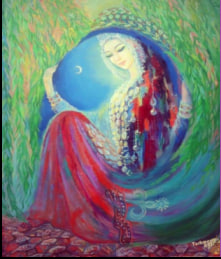Did you know that not only men, but also women were leaders of Sufi orders?
🔴 Two stars of Kokand
🔴 Rediscovering the legacy of female Sufi poetesses at the center of Islamic Civilization in Uzbekistan
When we turn the pages of classical Uzbek literature, the names of male Sufi poets are mentioned far more often. The works of Sufi leaders and mystics have been studied for many years, enriched with books and articles. However, in this process, female Sufi poets, their spiritual quests, and their poetic heritage have often remained overlooked. Their collections were lost, manuscripts scattered, and some were never preserved at all.
Yet these works form a refined and profound layer of Turkic Sufi thought. The spiritual sensitivity, inner anguish, and devotion to divine love reflected in female Sufi poetry give a unique color to the tradition of Sufi literature.
Among such forgotten legacies, two figures stand out from the Kokand literary environment of the late 19th and early 20th centuries — Shoira Khoniy and Niso Khonim.
Shoira Khoniy: from Kokand to Mecca
 Shoira Khoniy (real name Bibi Maryamkhan) was born near Kokand in 1884. She grew up in a scholarly family; both her father and mother were people of learning. Later, she became affiliated with the Qadiriyya order, and her poetry deeply expressed Sufi spirituality.
Shoira Khoniy (real name Bibi Maryamkhan) was born near Kokand in 1884. She grew up in a scholarly family; both her father and mother were people of learning. Later, she became affiliated with the Qadiriyya order, and her poetry deeply expressed Sufi spirituality.
In 1957, she set out for pilgrimage and never returned, spending the rest of her life in Jilikul. Her works such as Mavludnoma, Mi‘rojnoma, compositions about Abdulqadir Jilani and Bahauddin Naqshband, as well as her epics, are considered bright examples of Uzbek Sufi literature. Today, more than 8,000 verses of her manuscripts are preserved in the Academy of Sciences and Kokand museums.
Niso Khonim: subtle spirituality and divine love
Niso Khonim (daughter of Ibrohim Khoja) was born near Kokand in 1879. She belonged to the Naqshbandiyya order, and her poetry vividly conveyed themes of patience, asceticism, spiritual purification, and divine love with great mastery.
The works of Khoniy and Niso represent a shining expression of divine anguish and courage within the female heart. One continued the aesthetic legacy of the Qadiriyya school, while the other carried on that of the Naqshbandiyya.
Media project: new life for a forgotten heritage
Today, the Center of Islamic Civilization in Uzbekistan is implementing a media project titled “Female Sufi Poetesses of Early 20th-Century Kokand: The Literary Legacy of Niso and Khoniy”. Within this project:
▪️ The collected works of the poetesses will be published in Uzbek and Turkish;
▪️ Monographs based on scholarly commentary and analysis will be prepared;
▪️ Their portraits, manuscripts, and samples of poetry will be displayed in the exhibition;
▪️ Through interactive exhibits and visual content, this heritage will be presented to the public.
These efforts are significant not only for bringing to light the personal heritage of two poetesses, but also for presenting the phenomenon of female Sufi poets to a wider audience.
Shahnoza Rahmonova
P/S. This article may be used by citing the official website of the Center.
Most read

Over 100 experts from more than 20 countries of the world are in Tashkent!

President of Serbia Aleksandar Vučić visited the Islamic Civilization Center in Uzbekistan

The Center for Islamic Civilization – a global platform leading towards enlightenment











